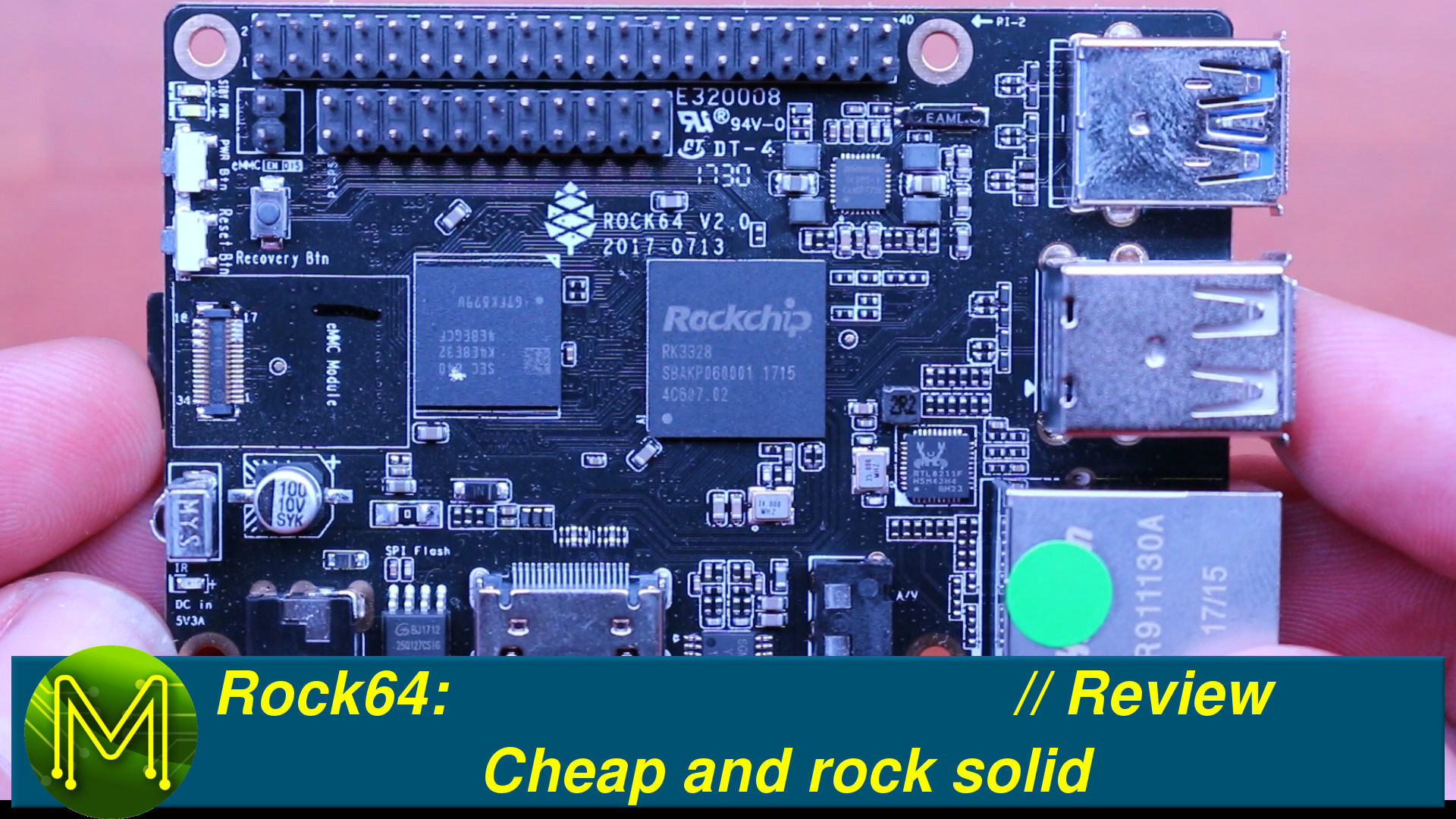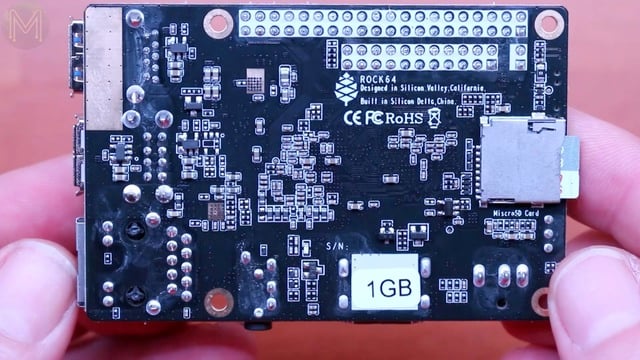Rock64: Cheap and rock solid // Review
It’s been a while since the Rock64 was released into the wild for hackers, but 8 months on, how good is this board looking? Let’s find out.
The back story
A lot of you will know about the original Pine64. It was a Kickstarter that launched back in December 2015. It looked like the best, cheapest SBC around, but unfortunately they ended up promising more than they could deliver.
The Pine64 guys have been steadily repairing their damaged reputation since and by the looks of their recent SBC, I reckon they’ve done a great job.The Rock64 was released to minimal fanfare - there weren’t any outrageous claims, like “Super Computer” and they have adopted more of WYSIWYG approach.
(UPDATE: In my travels, I’ve discovered that this design may be very similar to the UNIC UC46 WiFi projector. I haven’t yet confirmed this.)
However, they’ve made it as easy as possible to get on board with this new SBC.They have also provided a customized flashing tool based on Etcher, where you can download and burn a number of O/S images.For tests within this video I ran several Linux distros:
What do you get?
So, what do you get for your hard earned US$25? Starting from the top right working clockwise.
- USB3.0 host port.
- Two USB2.0 ports.
- GbE.
- Audio/Visual jack.
- HDMI out capable of 4K at 60Hz.
- 5v/3A DC power jack.
- IR receiver.
- eMMC socket.
- Reset button.
- Flash recovery button.
- Power button.
- Standard Pi2 GPIO header.
- And an additional header breaking out 12 more GPIOs and 100MbE. The first 8 pins are compatible with the Raspberry Pi P5 header. We also have:
RK805 - is a RockChip designed PMIC that not only has 4 DC buck converters, soft start and power sequencing but an on-board RTC accessible over I2C.
RTL8211F - GbE transceiver.
SGM89000 - A stereo line driver, which has a decent Signal to Noise ratio of around 114dB.
25Q127CSIG - 128Mb SPI flash.
K4E8E324EB-EGCF - On this board, at least, 1G LPDDR3 RAM. You can also have 2G or 4G LPDDR3 RAM.
RK3288 - And lastly the RK3328, which is a 64 bit quad core SoC with frequency scaling up to 1.3GHz.
On the flip side it’s really quite boring with only an SD slot. OK… Moving on.GPIO tests
So from the GPIO perspective what works and what doesn’t?
I had no issues with either of the I2C buses. My handy dandy, (MCP9808), temperature sensor responded OK on every O/S.GPIOs were also accessible without issue. However, SPI was another thing altogether. In every distro, SPI wasn’t available at all. It was certainly present in the Device Tree, but there was no working kernel module.Looking at the RK3328 datasheet, there should be 3 SPI buses. However, on the schematic, SPI2 goes directly to SPI flash and also the Pi GPIO header.This is almost guaranteed to cause issues with some SPI devices when using the SPI flash for booting.
However, you can read the SPI flash easily via the MTD subsystem interface.Docker Tests
I added in the Docker Image tests this time around as I believe Docker is the future for SBC Makers. From the casual Maker perspective - it allows you to “spin up” services without having to go through complicated install guides.
Once installed, you have a blank slate, which is easily filled with, for example, an OwnCloud image.
Just pull it from Docker Hub.docker pull owncloud
docker run -d -p 80:80 owncloud
docker start owncloud
Pretty easy stuff.
Network Performance
On the network performance side I noticed a slight increase in TCP throughput compared to last time.
Using stock Debian I saw 618Mb/s, while on the Xenial Docker image it bumped up to 881Mb/s.I did see the same ugly network dropout issue appearing on all the distros except for Xenial, requiring me to force the NIC to 100Mbit, full duplex.However, Xenial does have a more recent Kernel version. I haven’t checked to see what has changed, but it looks like that issue has finally been fixed.
Phoronix performance tests
Moving on to Phoronix tests. I cracked out my Uber heatsink again to ensure the CPU frequency didn’t scale down
and hammered it on two of the Linux distros.- DietPi
- Xenial.
Idle temperature
There was only around a 2-3 degree drop in temperature when adding the heatsink whilst idle. I saw an average of 36C with an ambient room temperature of 28C.
- Max: 40
- Average: 36
- Median: 35
- Min: 31.8I ran a number of Phoronix tests. One test that I would have liked to include was a crypto-currency benchmark, but none supported the Rock64 from the current Phoronix release.
I concentrated the benchmarks on CPU and I/O performance. I didn’t do any 4K graphics tests because, alas, I don’t have a 4K display. If you want to see some graphics benchmarks, then check out the CNX software review, (Part 1 and Part 2).
RAMspeed
On RAMspeed tests, the Rock64 jostled for position with FriendlyElec boards, HiKey and TinkerBoard but was regularly half the speed of the UDOO X86.SmallPT
On SmallPT, it sat around the middle of the pack with other boards priced at two times. In terms of performance, there wasn’t much in it.FFTE
FFTE tests had the Rock64 showing up the almost untouchable UDOO X86 and was twice as fast as the Pi3.Compression
While the gzip and pbzip2 file compression results were surprisingly laggy.However, almost all the results were similar, with the Rock64 sitting in among all the other boards I’ve tested so far. This is actually pretty good, considering what you’re getting.
Testing temperature
Throughout the Phoronix tests I saw the temperature stay around the 38C mark, with a peak of 56.8C during the Timed HMMER tests, which always pushes the temperature up on SoCs.
- Max: 56.8
- Average: 38
- Median: 35
- Min: 30.5While the average power consumption was around 800mA, with a peak of 1.1A. Incidentally, while powered off, it draws a little under 100mA, which is fairly low for an SBC.
Summary
So, what do I think of the Rock64?
I think this time round it’s a much better offering from Pine64. It’s clear that they have learned their lesson and are concentrating on building quality products cheaply, which was their MO from the beginning. Even though their marketing was dubious.
From what I can see, most of the community are concentrating on NAS and storage and not so much on the traditional Maker side of this board. No surprise there, because for US$25 you get a board that can push out 4K at 60Hz, along with GbE and USB3.0.
I suspect that the SPI flash chip will cause some devices to not play nice on the SPI bus, leaving it largely useless for things like OLED displays, but the jury is still out on that one.
In terms of heat dissipation. You could actually get by without a heatsink for most applications as the SoC runs fairly cool, but I suspect that when viewing 4K video, things would get pretty hot.
So, we are finally seeing what the Pine64 product would have been like and it’s a good lesson for any SBC company out there: 1. Don’t promise the world. 2. Make on-boarding easy. 3. Respect the community you are developing.
Linky Links
- Phoronix Rock64 results
- Mega comparison of all boards I’ve tested so far.
- CNX-software Rock64 review - Part 1 and Part 2.
- Rock64 at Pine64


























